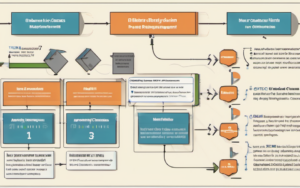The journey of Blockchain Evolution is a fascinating one, starting with a single white paper and blossoming into a technology transforming numerous industries. Its impact is undeniable, and understanding its history is crucial to grasping its potential. Let’s explore this remarkable evolution.
The Genesis of Blockchain: Satoshi Nakamoto’s Vision
The Bitcoin White Paper: A Revolutionary Idea
In 2008, a mysterious figure or group, known as Satoshi Nakamoto, published a white paper titled “Bitcoin: A Peer-to-Peer Electronic Cash System.” This document outlined a revolutionary idea: a decentralized digital currency system using cryptography to secure transactions and control the creation of new units. This marked the genesis of blockchain technology, although the term “blockchain” itself wasn’t prominently used in the initial paper. The paper’s impact reverberated across the technological world, planting the seed for a decentralized future.
The core innovation lay in its novel approach to distributed ledger technology. Unlike traditional centralized systems, Bitcoin’s transactions were recorded on a shared, public ledger – the blockchain – accessible to all participants. This ensured transparency and immutability, creating a system resistant to censorship and single points of failure. This revolutionary concept challenged the established financial order, setting the stage for a significant shift in how we think about transactions and trust.
Early Adoption and the Rise of Cryptocurrency
Following the publication of the white paper, the Bitcoin network launched in 2009. Early adoption was slow, but the potential of a decentralized, secure, and censorship-resistant currency began to attract attention. The gradual increase in users and the subsequent rise in Bitcoin’s value highlighted the potential of blockchain technology. This early period laid the foundation for future developments and spurred further research into the underlying technology. The evolution of blockchain technology since 2008 is intrinsically linked to this initial success and the growing understanding of its potential applications beyond cryptocurrency. Studying the history of blockchain white papers reveals a shift from a narrow focus on digital currency to a broader understanding of its potential to disrupt various sectors.
Beyond Bitcoin: The Evolution of Blockchain Technology
Smart Contracts and Decentralized Applications (DApps)
Beyond its initial application in cryptocurrency, the potential of blockchain technology quickly became apparent. The concept of smart contracts, self-executing contracts with the terms of the agreement directly written into code, emerged as a significant development. This enabled the creation of decentralized applications (DApps), applications that run on a distributed network rather than a central server, offering enhanced security, transparency, and resilience. Smart contracts automated processes, removing the need for intermediaries and increasing efficiency. This diversification of blockchain’s applications marked a significant step in its evolution.
The development of Ethereum, a blockchain platform designed to support smart contracts, further fueled this evolution. Ethereum’s introduction of the concept of “gas” for transaction fees and its more flexible scripting language made it a much more versatile platform for developing DApps. This broadened the range of applications from simple cryptocurrency transactions to more complex applications such as supply chain management and decentralized finance (DeFi).
Consortium Blockchains and Enterprise Adoption
The initial focus on public blockchains like Bitcoin and Ethereum gradually shifted to explore the potential of private and consortium blockchains. Consortium blockchains, shared by a select group of organizations, offer a balance between the decentralization of public blockchains and the control needed for enterprise applications. This enabled businesses to leverage blockchain technology for improving efficiency and security without sacrificing control or exposing sensitive data to the public. Many large corporations started exploring the integration of blockchain technology into their processes, driving innovation and adoption.
The shift towards enterprise blockchain solutions addressed several concerns related to scalability, privacy, and regulatory compliance. The need for permissioned access and customized governance models became crucial for enterprise adoption. This phase signified a significant step in the evolution of blockchain technology, demonstrating its adaptability and relevance across various sectors.
Proof-of-Stake and Other Consensus Mechanisms
The original Bitcoin blockchain utilized a consensus mechanism called Proof-of-Work (PoW), requiring significant computational power to validate transactions. This was energy-intensive and led to concerns about environmental impact. The development of alternative consensus mechanisms, such as Proof-of-Stake (PoS), addressed these issues. PoS reduces energy consumption by selecting validators based on the number of tokens they hold, rather than computational power. This evolution improved the efficiency and sustainability of blockchain networks. Many other consensus mechanisms, like delegated proof-of-stake (DPoS), are also being explored, each offering unique advantages and trade-offs. The ongoing research into consensus mechanisms is a crucial aspect of blockchain evolution.
The Impact of Blockchain on Various Industries
Finance: Decentralized Finance (DeFi) and Tokenization
The financial industry has witnessed some of the most significant impacts of blockchain technology. Decentralized finance (DeFi) applications built on blockchain platforms offer alternatives to traditional financial services, such as lending, borrowing, and trading. Tokenization, the process of representing assets as digital tokens on a blockchain, is transforming how we own and trade assets, increasing liquidity and efficiency. This has major implications for investment, securities trading, and other financial processes.
The emergence of stablecoins, cryptocurrencies pegged to the value of fiat currencies, has further enhanced the usability of cryptocurrencies and DeFi applications. Stablecoins aim to minimize volatility, making them more suitable for everyday transactions and reducing the risks associated with using highly volatile cryptocurrencies. The increasing sophistication and adoption of DeFi platforms demonstrate the transformative power of blockchain in the financial sector.
Supply Chain Management: Transparency and Traceability
Supply chain management is another area where blockchain has shown significant promise. Blockchain’s immutability and transparency can be leveraged to track goods and materials throughout the supply chain, increasing visibility and reducing fraud. This improves efficiency, accountability, and consumer trust. Products can be traced from origin to consumer, enabling better quality control and faster response to issues.
The implementation of blockchain in supply chain management leads to improved traceability, enabling businesses to quickly identify the source of any problems or contamination. This improved transparency enhances consumer trust and allows for faster and more efficient recall processes when necessary. The positive impact on the entire supply chain makes blockchain a powerful tool for optimization.
Healthcare: Secure Data Sharing and Patient Empowerment
Blockchain technology offers numerous benefits for the healthcare industry, particularly in secure data sharing and patient empowerment. Patients can gain control over their health data, allowing them to share information selectively with healthcare providers while maintaining privacy and security. The immutability of blockchain helps maintain data integrity and reduces the risk of tampering or unauthorized access.
The use of blockchain in healthcare also enhances the efficiency of clinical trials and drug development by enabling secure data sharing and collaboration among researchers and healthcare providers. The transparency and security offered by blockchain contribute significantly to building trust and improving the overall quality of care.
The Future of Blockchain: Challenges and Opportunities
Scalability and Interoperability
Despite its advancements, blockchain technology still faces challenges. Scalability remains a key concern, as many blockchain networks struggle to handle a large volume of transactions efficiently. Interoperability, the ability for different blockchain networks to communicate and share data seamlessly, is also crucial for widespread adoption. Addressing these challenges is crucial for unlocking the full potential of blockchain technology.
Solutions such as sharding, layer-2 scaling solutions, and cross-chain communication protocols are currently being developed and implemented to address scalability and interoperability issues. These advancements are paving the way for more efficient and interconnected blockchain ecosystems.
Regulation and Governance
The regulatory landscape surrounding blockchain technology is constantly evolving. Clear and consistent regulations are necessary to foster innovation and protect consumers while preventing malicious activities. Establishing robust governance mechanisms within blockchain networks is also crucial to ensure their long-term sustainability and trustworthiness. The regulatory environment will significantly impact the future adoption and development of blockchain technology.
Governments worldwide are grappling with how best to regulate blockchain technology, balancing innovation with the need to protect consumers and prevent illicit activities. The development of clear regulatory frameworks is crucial for the continued growth and adoption of blockchain technology.
The Potential for Disruptive Innovation
Despite the challenges, the potential for blockchain technology to disrupt various industries remains immense. Its ability to enhance transparency, security, and efficiency has the power to transform how we conduct business, manage data, and interact with each other. Continuous innovation and development will further expand its applications and impact. The ongoing research and development efforts in the field suggest a bright future for blockchain technology and its potential to revolutionize various aspects of our lives.
A paradigm shift in trust and decentralization is underway, driven by the evolution of blockchain technology. The promise of a more transparent and efficient future, empowered by blockchain, is rapidly becoming a reality. The journey from a single white paper to the diverse ecosystem we see today is a testament to the enduring power of this revolutionary technology. As research continues, and solutions to scalability and regulatory hurdles are found, we can expect even more transformative applications of this innovative technology in the years to come.




